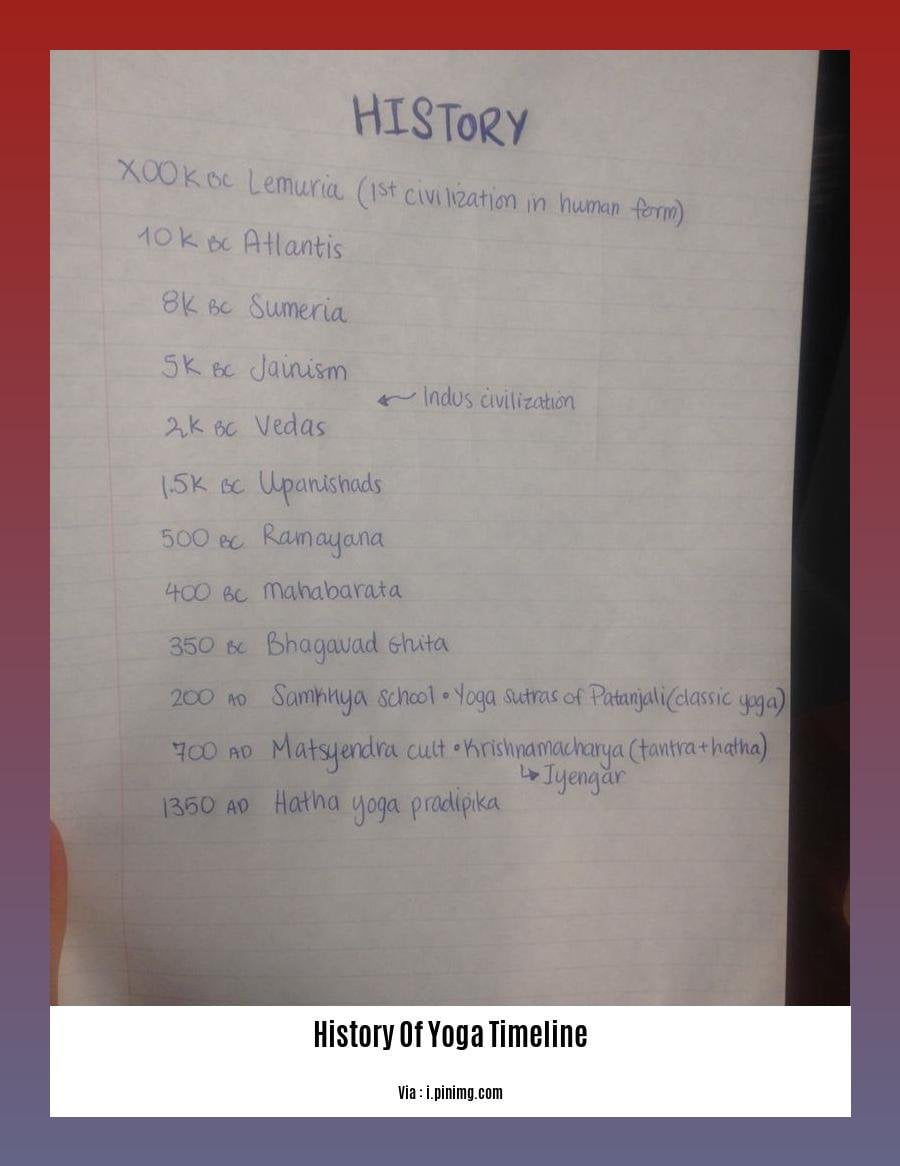Embark on a historical expedition through the world of yoga, discovering its profound journey from ancient Indian origins to its status as a globally recognized practice. Explore the evolution of yoga through the ages, tracing its transformative impact on human well-being and cultural landscapes. Delve into the profound teachings embedded within ancient scriptures and gain insights from renowned yoga practitioners. Uncover the secrets of yoga’s enduring legacy in [A Historical Journey Through the Centuries: Unraveling the History of Yoga Timeline].
Key Takeaways:
8,000 – 10,000 BCE: Yoga first mentioned in the Rigveda, an ancient Indian scripture.
5,000 BCE: Maharishi Patanjali introduces the concept of Yoga.
In medieval times between 500 and 1500 AD, Yoga took on various forms.
Yoga appears in Buddhist scripts during the 8th century.
In the 1890s, Westerners began learning Yoga.
Yoga reached the United States in the 1930s, gaining widespread recognition.
History of Yoga Timeline

Yoga has been practiced for thousands of years, evolving and adapting to various cultures worldwide. Here’s a historical journey through the history of yoga timeline:
Pre-Classical Period (8,000 – 10,000 BCE)
- The earliest mentions of yoga can be traced back to the ancient Indian text, the Rig Veda, emphasizing physical postures and meditation.
Classical Period (200 – 500 CE)
- The Yoga Sutras of Patanjali solidified yoga’s philosophical foundation, outlining yoga’s eight limbs and guiding practitioners toward spiritual enlightenment through physical postures and mental practices.
Medieval Period (500 – 1500 CE)
- Yoga diversified into various forms, with different schools and lineages emerging. Influential texts like the Hatha Yoga Pradipika focused on hatha yoga, emphasizing physical postures and control of the breath.
Modern Period (19th Century and Onward)
Western interest in yoga grew in the 19th century when Swami Vivekananda introduced yoga to the West during the World’s Parliament of Religions in Chicago.
The 20th century witnessed the global spread of yoga. Influential figures like B. K. S. Iyengar, T. K. V. Desikachar, and Pattabhi Jois popularized various yoga styles.
The 21st century has seen yoga’s transformation into a mainstream practice, with different styles and variations catering to diverse populations worldwide.
Yoga in the 21st Century: Embracing Diversity and Accessibility
Today, yoga is practiced in studios, gyms, and homes worldwide, offering various benefits, including improved flexibility, strength, and mental well-being.
Emphasis on Inclusivity: Yoga has become more inclusive, with modifications and adaptations to accommodate different needs and abilities.
Technology and Online Platforms: Online classes, tutorials, and apps have made yoga accessible to a broader audience, fostering a global yoga community.
Yoga as a Therapeutic Practice: Yoga’s benefits in reducing stress, anxiety, and promoting overall wellness have led to its integration into healthcare and therapeutic settings.
Yoga and Mindfulness: Combining yoga with mindfulness techniques has gained popularity, promoting a deeper connection between body and mind.
The history of yoga timeline reflects a continuous evolution, adapting to changing times while maintaining its core principles of physical and mental well-being.
Want to explore the ancient roots of yoga? Dive into the captivating history of yoga in short.
Journey through time with our interactive timeline of world history and uncover the pivotal moments that shaped our world.
Considering history as an optional subject for UPSC? Delve into the pros and cons with our insightful analysis: Is history a good optional for UPSC.
Hatha Yoga: Hatha yoga, emphasizing physical postures and breathing techniques, emerged in the 15th century CE, popularized by yogis like Matsyendranath and Gorakhnath.

Beginning in the 15th century, Hatha Yoga, a branch of yoga emphasizing physical postures and breathing techniques, emerged in India. This form of yoga, popularized by yogis like Matsyendranath and Gorakhnath, focused on balancing the opposing energies of the body and mind.
Exploring the Roots of Hatha Yoga
Emphasis on Physicality: Unlike earlier forms of yoga that primarily focused on meditation and breath control, Hatha Yoga introduced a systematic approach to physical postures.
Balancing Opposites: Hatha Yoga aimed to achieve harmony by counterbalancing the opposing forces within the body and mind, fostering a sense of equilibrium.
Yogis and Their Influence: Matsyendranath and Gorakhnath, renowned yoga masters, played a crucial role in disseminating Hatha Yoga’s teachings and practices.
Key Takeaways:
Unique Approach: Hatha Yoga’s emphasis on physical postures set it apart from earlier forms of yoga, introducing a more dynamic and holistic practice.
Balancing Act: Hatha Yoga’s focus on balancing opposing energies sought to create harmony and equilibrium within the body and mind.
Influential Yogis: Matsyendranath and Gorakhnath were instrumental in spreading Hatha Yoga’s teachings, contributing to its enduring legacy.
Citations:
Globalization of Yoga: In the 19th century, yoga was introduced to the West through the writings of Swami Vivekananda and other Indian teachers, leading to its global recognition.
In the late 1800s, the world was abuzz with an insatiable curiosity for the ancient practices of the East. Among these, yoga stood out as a beacon of Eastern wisdom, ready to illuminate the lives of Western seekers.
The Catalyst: Swami Vivekananda’s Pioneering Role
The year was 1883 when a young Indian monk named Swami Vivekananda stepped onto American soil. His mission: to introduce the world to the profound teachings of yoga and Vedanta philosophy. With eloquence and conviction, Vivekananda captivated audiences at the World’s Parliament of Religions in Chicago, painting a vivid picture of yoga’s transformative power.
The Ripple Effect: Yoga’s Journey West
Vivekananda’s electrifying presence at the Parliament ignited a spark of interest in yoga that would soon fan into a blazing inferno. His lectures, peppered with demonstrations of yogic postures and breathing techniques, left an indelible mark on Western minds.
As the 19th century drew to a close, yoga began its gradual journey westward. Through the writings of Vivekananda and other Indian teachers, yoga’s teachings spread like wildfire, capturing the imagination of those seeking a deeper connection to themselves and the world around them.
Key Takeaways:
- In the 19th century, yoga’s journey to the West was spearheaded by Swami Vivekananda, whose teachings at the World’s Parliament of Religions in Chicago ignited a global fascination with this ancient practice.
- Yoga’s introduction to the West coincided with a growing interest in Eastern philosophies and practices, as people sought alternative approaches to health and well-being.
- Vivekananda’s emphasis on yoga’s spiritual and philosophical dimensions resonated with Western seekers, who were eager to explore the deeper meanings of life.
References:
- Yoga Journal: The Westernization of Yoga
- BBC News: How Yoga Became a Global Phenomenon
Modern Adaptations: In the 20th and 21st centuries, yoga has diversified into various styles, including Ashtanga, Iyengar, and Vinyasa, tailored to different needs and preferences.
In the 20th century, yoga underwent a renaissance, becoming a global phenomenon. This transformation was fueled by the efforts of dedicated yogis who adapted and refined the ancient practice to suit the needs of modern practitioners.
Important Styles Emerging from Yogic Evolution
- 19th-century: Swami Vivekananda, one of yoga’s most influential ambassadors, played a pivotal role in introducing the practice to the West. His teachings focused on the philosophical and spiritual aspects, laying the foundation for the yoga we know today.
- Early 20th-century: This period witnessed the emergence of innovative styles that emphasized physical postures. Notable figures like T. Krishnamacharya and B. K. S. Iyengar were at the forefront of this evolution.
Ashtanga: Developed by Pattabhi Jois in the mid-20th century, Ashtanga is a vigorous style characterized by a set sequence of postures performed with synchronized breathing.
This dynamic practice focuses on building strength, flexibility, and mental focus.
Iyengar: Founded by B. K. S. Iyengar, Iyengar yoga emphasizes precision, alignment, and the use of props to support and enhance the poses.
This approach is ideal for those seeking therapeutic benefits or needing modifications due to injuries or physical limitations.
Vinyasa: A popular contemporary style, Vinyasa yoga is characterized by flowing sequences of poses linked together with the breath.
This dynamic practice is known for its energizing and meditative qualities.
Yoga’s Transformation Mirrors Societal Shifts
The evolution of yoga mirrors the changing needs and preferences of society. In the 21st century, yoga has become increasingly inclusive, with styles such as Yin yoga, Restorative yoga, and Chair yoga gaining popularity. These styles are designed to cater to specific populations, including those with injuries, seniors, and those seeking a gentler practice.
Key Takeaways:
- Yoga’s journey from ancient India to its global recognition is a testament to its adaptability and resilience.
- In the 20th and 21st centuries, yoga diversified into various styles, each catering to different needs and preferences.
- Styles like Ashtanga, Iyengar, and Vinyasa emerged as prominent adaptations of traditional yoga.
- Modern yoga is characterized by inclusivity, with styles designed for specific populations and therapeutic benefits.
- Yoga’s evolution reflects its ability to adapt to changing societal needs and preferences.
Citation:
– The History of Yoga
– The Globalization of Yoga
FAQ
Q1: When did yoga originate, and where?
A1: Yoga originated in ancient India and has a rich history dating back over 5,000 years.
Q2: What is the etymology of the word “yoga”?
A2: The word “yoga” is derived from the Sanskrit word “yuj,” which means “to join” or “to unite.”
Q3: What is the primary goal of yoga?
A3: Yoga aims to unite the mind, body, and spirit, promoting physical, mental, and spiritual well-being.
Q4: Which form of yoga is considered the earliest known?
A4: Hatha yoga, which focuses on physical postures and breathing exercises, is considered the earliest known form of yoga.
Q5: How did yoga spread to the West?
A5: Yoga’s journey to the West can be traced back to the late 19th and early 20th centuries, influenced by factors such as Swami Vivekananda’s promotion of yoga as a “science of the mind,” the global fascination with natural fitness, and the counter-culture movements of the 1960s.
- Mastering Leader in Spanish: The Complete Guide - April 19, 2025
- Uncovering Surprising Parallels: England Size Compared to US States - April 19, 2025
- Old Mexico Map: Border Shifts 1821-1857 - April 19, 2025
















